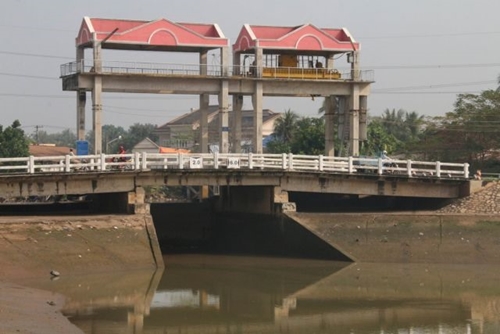Many provinces have been bracing for it following a forecast that the intrusion of seawater up rivers would be early and severe this year.
    |
 |
|
Go Cat sluice in Tien Giang Province’s My Tho City has been shut to keep out seawater. |
They have taken measures like dredging and shoring up canals, building temporary dams to keep out saltwater and store water for irrigation and installing water supply facilities.
In Tra Vinh province, saltwater has entered 50-55 kilometers upstream in the Co Chien and Hau rivers, according to the local Department of Agriculture and Rural Development.
Pham Minh Truyen, director of the department, said the Southern Institute of Water Resources Research had warned of unusually early drought and saltwater intrusion during the 2019-20 winter-spring rice crop.
It would be difficult to get freshwater at the Cai Hop sluice in the Co Chien river and the Can Chong sluice in the Hau River between January and March, he said.
The water salinity at the Cai Hop sluice reached 5.4 per thousand last week.
The department has called on farmers to stop sowing the winter-spring rice.
Tra Vinh plans to grow 66,000ha of rice and farmers have sowed more than 40 percent of it, according to the department.
The department, in cooperation with localities affected by the saltwater, has helped rice farmers switch to drought-resistant crops.
It has asked its Irrigation Sub-department to strengthen forecasting about saltwater intrusion so that local authorities and farmers could take measures to secure freshwater.
It has instructed the province’s Clean Water and Environment Sanitation Center to ensure daily supply of water to 9,000 rural households in areas vulnerable to drought and saltwater intrusion.
The delta provinces have instructed farmers in saltwater-affected areas to store freshwater in fields, ponds and containers to ensure they have enough water to irrigate their crops in the dry season.
Nguyen Thien Phap, head of Tien Giang province's Sub-department of Irrigation and Flood and Storm Prevention and Control, said the water levels in the upstream areas of the Tien river, a distributary of the Mekong river, are very low.
The province would suffer from severe saltwater intrusion and water shortage in the dry season, he said.
Seawater has flowed around 60km up the Tien river in Tien Giang province, the country’s largest fruit producer, which has closed sluices and dams to keep out the saltwater and store fresh water to irrigate 150,000ha of rice, fruits and vegetables and supply households.
Source: VNA